Baoshan Iron & Steel Bundle
Who Really Owns Baoshan Iron & Steel Company?
Understanding a company's ownership structure is paramount for investors and strategists alike. Baoshan Iron & Steel Company (Baosteel), a giant in the Chinese steel industry, presents a compelling case study. Its initial public offering (IPO) was a landmark event, but who truly controls this industrial powerhouse?
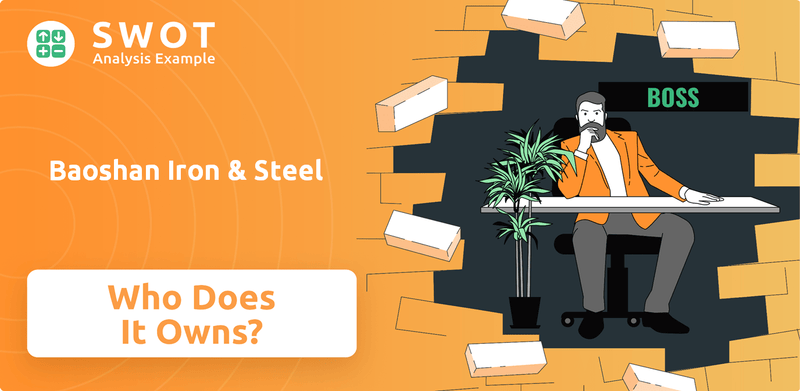
This deep dive into Baoshan Iron & Steel SWOT Analysis will unravel the complexities of Baosteel ownership, from its roots to the present day. We'll examine the influence of the Baosteel Group and the Chinese government, shedding light on the major shareholders and the company's corporate governance. Discover how Baosteel's ownership structure impacts its strategic direction and its role in the global steel market, providing crucial insights for informed decision-making.
Who Founded Baoshan Iron & Steel?
The story of Baoshan Iron & Steel Company, or Baosteel, begins with the establishment of the Baosteel Group. The company's origins are deeply rooted in China's economic reforms, aimed at boosting large-scale steel production. This initiative led to the founding of Baoshan Iron and Steel in 1978 in Shanghai's Baoshan District.
Baoshan Iron & Steel Co., Ltd. was officially registered on February 3, 2000. The company was established as a sole establishment by Baosteel Group Corporation, which was originally known as Shanghai Baosteel Group Corporation. This marked a significant step in the evolution of the steel giant.
The structure of Baosteel's ownership reflects its origins as a state-backed enterprise. The initial formation of the listed entity, Baoshan Iron & Steel Co., Ltd., came from its parent company, the Baosteel Group (now China Baowu Steel Group). From the very beginning, the Baosteel Group held the position of controlling shareholder.
Baoshan Iron & Steel was founded in 1978, during China's economic reforms. This marked the beginning of its journey towards becoming a major player in the Brief History of Baoshan Iron & Steel.
The listed company, Baoshan Iron & Steel Co., Ltd., was officially registered in 2000. It was formed by the Baosteel Group Corporation.
Baosteel Group (now China Baowu Steel Group) was the controlling shareholder. The initial structure showcased the state's influence in the Chinese steel industry.
Baoshan Iron & Steel took over businesses, assets, and liabilities from Baosteel Group. This transfer was facilitated by issuing ordinary shares to the parent company.
In 1998, the original Baoshan Iron & Steel (Group) Corporation merged with other entities. This merger led to the creation of Shanghai Baosteel Group Corporation.
The merged entity became China's largest integrated steelworks. It had an annual production capacity of nearly 20 million tons.
Understanding the ownership structure of Baoshan Iron & Steel, or Baosteel, is crucial for grasping its position within the Chinese steel industry. The company's roots are firmly planted in state-led initiatives. The Baosteel Group's initial control highlights the role of the Chinese government in shaping the steel sector. The company’s evolution, from its founding to its current status as a major player, reflects strategic mergers and production capacity expansions.
- Baosteel's formation was part of China's economic reforms.
- The Baosteel Group was the initial controlling shareholder.
- The company's structure reflects its state-owned enterprise status.
- Baosteel's history includes strategic mergers and acquisitions.
Baoshan Iron & Steel SWOT Analysis
- Complete SWOT Breakdown
- Fully Customizable
- Editable in Excel & Word
- Professional Formatting
- Investor-Ready Format
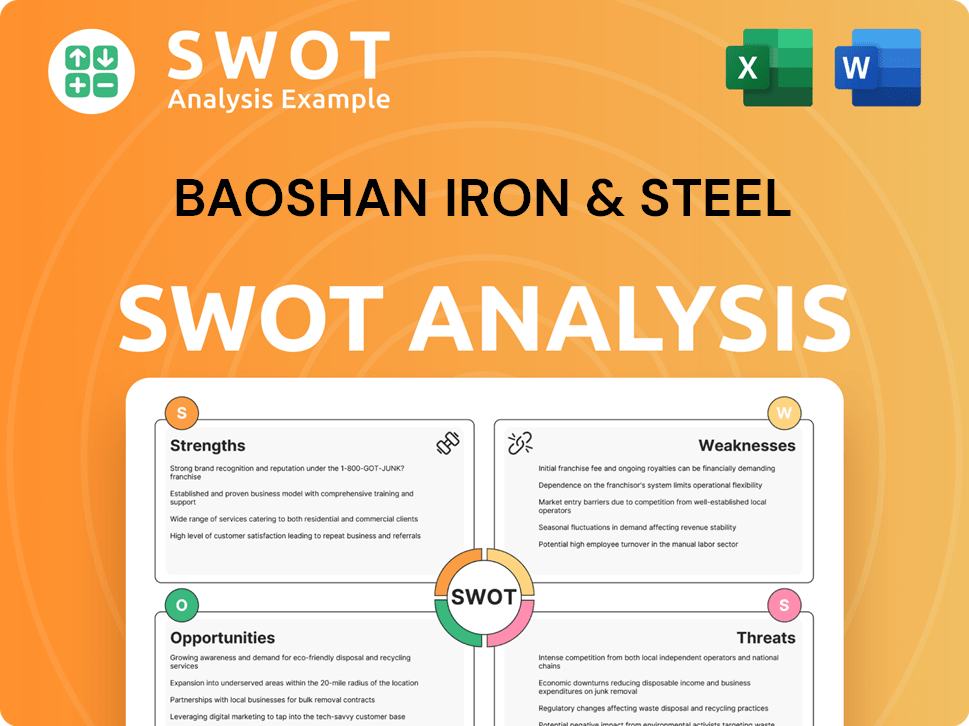
How Has Baoshan Iron & Steel’s Ownership Changed Over Time?
The evolution of Baoshan Iron & Steel Company's ownership reflects its growth within the Chinese steel industry. Initially, Baosteel Group, now known as China Baowu Steel Group, held the controlling stake. This group is ultimately owned by the Chinese Central Government. Over time, the ownership structure has been influenced by key events, including initial public offerings (IPOs), mergers, and strategic acquisitions.
One of the most significant events was the IPO on December 12, 2000, which raised CNY 7.7 billion. Another major change occurred in 2016 when Baosteel Group merged with Wuhan Iron and Steel Group (WISCO) to form China Baowu Steel Group. This merger involved Baoshan Iron & Steel taking over the listed assets of Wuhan Iron and Steel Group. Furthermore, cross-ownership arrangements and acquisitions of other steel companies like Meishan Iron & Steel Co., Ltd., and Zhanjiang Iron & Steel Co., Ltd. have reshaped the company's ownership landscape. In April 2025, Baosteel planned to invest 9 billion yuan to acquire a 49% stake in Maanshan Iron & Steel Co., Ltd. (Ma Steel Limited), a subsidiary of Maanshan Iron & Steel Co., Ltd.
| Ownership Category | Stake Percentage | Notes |
|---|---|---|
| China Baowu Steel Group Co., Ltd. | 50% | Largest shareholder |
| Private Companies | 54% | Collective ownership |
| Institutional Ownership | 25% | |
| General Public | 21% | Primarily individual investors |
The current ownership structure shows a diverse mix of stakeholders. China Baowu Steel Group Co., Ltd. remains the largest shareholder with a 50% stake. Private companies collectively hold 54% of the stock, while institutional ownership accounts for 25%. The general public, mainly individual investors, owns the remaining 21%. For more insights, you can explore the Target Market of Baoshan Iron & Steel.
Baoshan Iron & Steel's ownership is primarily controlled by China Baowu Steel Group, owned by the Chinese government.
- The IPO in 2000 raised CNY 7.7 billion.
- A merger with Wuhan Iron and Steel Group in 2016 formed China Baowu Steel Group.
- Private companies hold a significant 54% stake in the company.
- The general public holds a 21% stake.
Baoshan Iron & Steel PESTLE Analysis
- Covers All 6 PESTLE Categories
- No Research Needed – Save Hours of Work
- Built by Experts, Trusted by Consultants
- Instant Download, Ready to Use
- 100% Editable, Fully Customizable
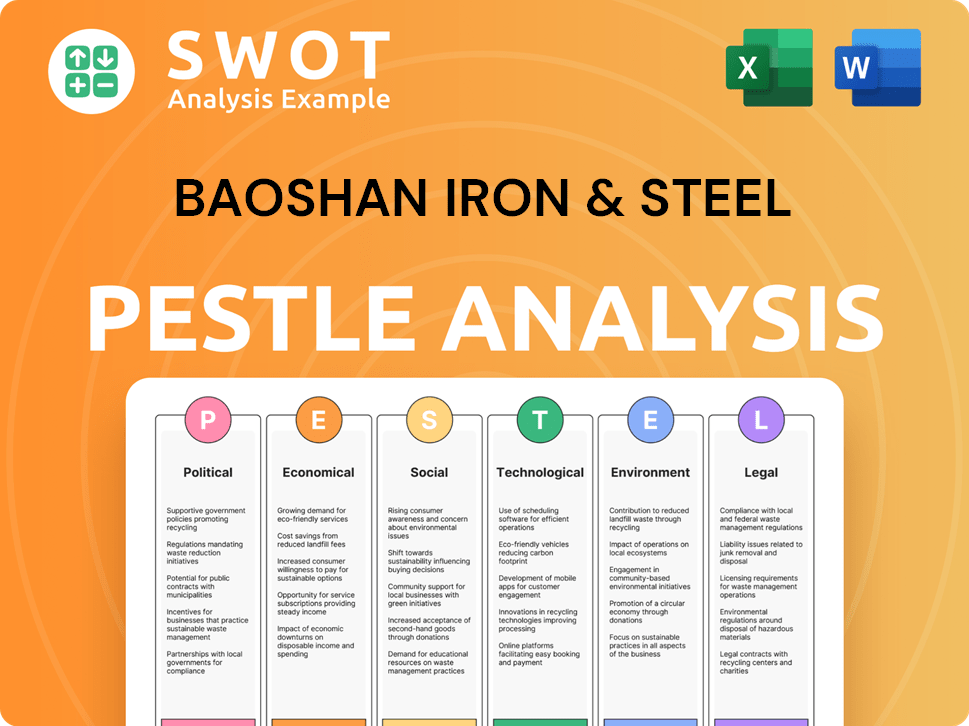
Who Sits on Baoshan Iron & Steel’s Board?
The current board of directors of Baoshan Iron & Steel Company plays a crucial role in the company's governance. As of April 2025, the leadership includes Mr. Zou Jixin as Chairman and Mr. Liu Baojun as Director and General Manager. Key members also include Mr. Xie Rong, an Independent Director; Ms. Wang Juan, Deputy General Manager, CFO, and Board Secretary; and Mr. Cai Yanbo, Deputy General Manager. This structure reflects a blend of executive and independent oversight, essential for managing a major player in the Chinese steel industry.
In June 2024, the board composition included executive directors Mr. Xie Zhixiong, Mr. Meng Wenwang, and Mr. Zou An. Non-executive directors were Mr. Song De An, Mr. Lin Changchun, and Mr. Zhou Ping, with independent non-executive directors Mr. Sheng Xuejun, Ms. Tang Ping, and Mr. Guo Jiebin also serving. This diverse group ensures comprehensive oversight and strategic direction for the company, reflecting the complex ownership structure and the influence of the Baosteel Group.
| Board Member | Title | Role |
|---|---|---|
| Zou Jixin | Chairman | Oversees overall company strategy |
| Liu Baojun | Director & General Manager | Manages daily operations |
| Xie Rong | Independent Director | Provides independent oversight |
The voting structure generally follows a one-share-one-vote principle. However, China Baowu Steel Group, as the controlling shareholder, holds significant influence. With approximately a 50% stake, the parent company, a state-owned enterprise, wields considerable power over the company's future. At the 2024 annual shareholders' meeting on May 20, 2025, shareholders representing 72.4519% of the company's shares were present. Notably, China Baowu Steel Group abstained from voting on related transaction resolutions, highlighting its direct involvement in key decisions and the impact on Baosteel ownership.
The board of directors includes a mix of executive and independent members, ensuring comprehensive oversight. The controlling shareholder, China Baowu Steel Group, significantly influences decisions.
- Board members represent major shareholders and independent interests.
- China Baowu Steel Group's ownership impacts the company's direction.
- Shareholder meetings reflect the balance of power and influence.
- Baosteel's governance structure is typical of a state-owned enterprise.
Baoshan Iron & Steel Business Model Canvas
- Complete 9-Block Business Model Canvas
- Effortlessly Communicate Your Business Strategy
- Investor-Ready BMC Format
- 100% Editable and Customizable
- Clear and Structured Layout
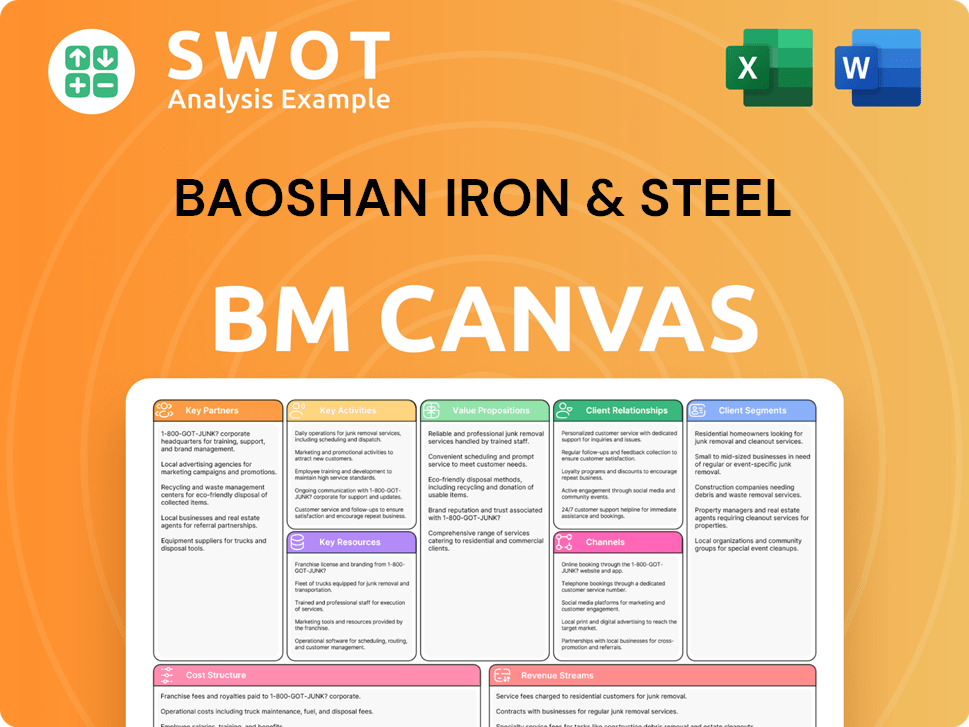
What Recent Changes Have Shaped Baoshan Iron & Steel’s Ownership Landscape?
In recent years, Baoshan Iron & Steel Company, or Baosteel, has seen significant developments in its ownership structure and strategic direction. A key move announced in April 2025 involves Baosteel investing 9 billion yuan to acquire a 49% stake in Maanshan Iron & Steel Co., Ltd. (Ma Steel Limited), a subsidiary of Maanshan Iron & Steel Co., Ltd. This is aimed at strengthening market competitiveness, as both entities are indirectly controlled by China Baowu, Baosteel's controlling shareholder.
The ownership landscape of Baosteel remains largely defined by the state-owned China Baowu Steel Group. While institutional investors hold a substantial 25% stake and the general public owns 21%, the 50% share controlled by China Baowu ensures significant influence over the company's decisions and strategic initiatives. This structure reflects the broader trends within the Chinese steel industry, where state-owned enterprises play a dominant role.
| Shareholder | Percentage | Notes |
|---|---|---|
| China Baowu Steel Group | 50% | Controlling Shareholder |
| Institutional Investors | 25% | Significant Stake |
| General Public | 21% | Publicly Traded Shares |
Financial performance has also influenced the company's outlook. In 2024, Baosteel reported a 38.4% year-on-year decline in net profit to 7.36 billion yuan, its lowest since 2016, due to falling steel prices and weak demand. However, Q1 2025 saw a 26.4% increase in net profit to approximately 2.43 billion yuan, driven by lower costs. The company anticipates a nationwide reduction in crude steel production in 2025, with a forecasted 50-million-ton drop from 2024 levels. Baosteel plans to produce 52.61 million tons of steel and 48.79 million tons of pig iron in 2025. Moreover, Baosteel aims to increase steel exports to 10 million tons per year by 2028.
Baosteel's ownership is primarily controlled by China Baowu Steel Group, a state-owned enterprise. Institutional investors and the public also hold significant shares.
A key recent development is Baosteel's plan to invest in Ma Steel Limited. This move is aimed at achieving market synergies.
Baosteel's 2024 profits decreased, but Q1 2025 saw a profit increase. The company plans to adjust production and increase exports.
Baosteel aims to produce 52.61 million tons of steel in 2025 and increase steel exports to 10 million tons by 2028.
Baoshan Iron & Steel Porter's Five Forces Analysis
- Covers All 5 Competitive Forces in Detail
- Structured for Consultants, Students, and Founders
- 100% Editable in Microsoft Word & Excel
- Instant Digital Download – Use Immediately
- Compatible with Mac & PC – Fully Unlocked
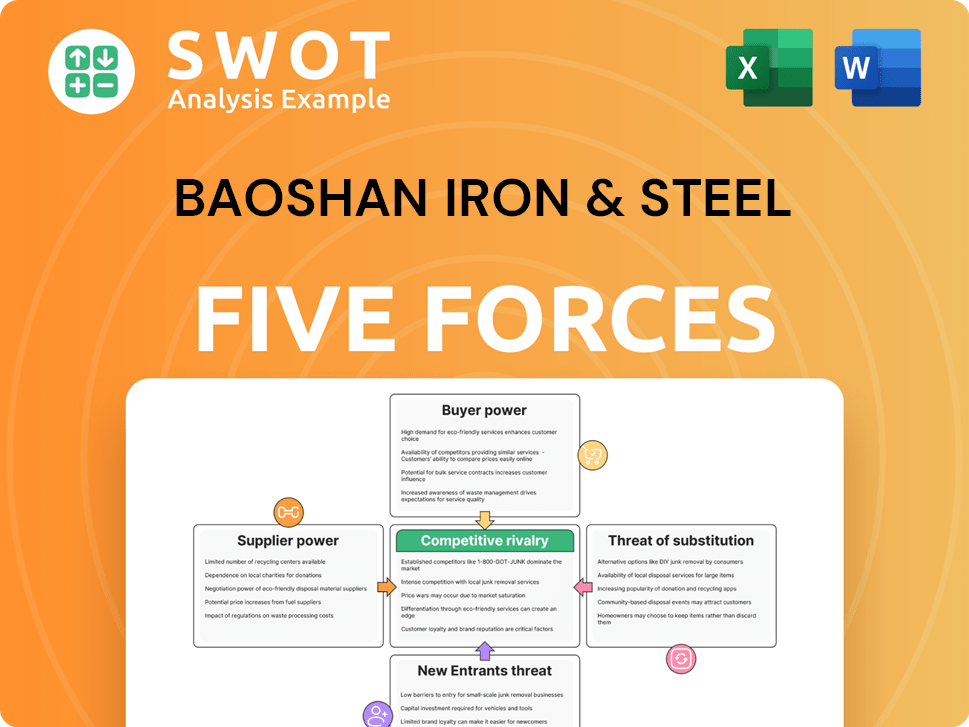
Related Blogs
- What are Mission Vision & Core Values of Baoshan Iron & Steel Company?
- What is Competitive Landscape of Baoshan Iron & Steel Company?
- What is Growth Strategy and Future Prospects of Baoshan Iron & Steel Company?
- How Does Baoshan Iron & Steel Company Work?
- What is Sales and Marketing Strategy of Baoshan Iron & Steel Company?
- What is Brief History of Baoshan Iron & Steel Company?
- What is Customer Demographics and Target Market of Baoshan Iron & Steel Company?
Disclaimer
All information, articles, and product details provided on this website are for general informational and educational purposes only. We do not claim any ownership over, nor do we intend to infringe upon, any trademarks, copyrights, logos, brand names, or other intellectual property mentioned or depicted on this site. Such intellectual property remains the property of its respective owners, and any references here are made solely for identification or informational purposes, without implying any affiliation, endorsement, or partnership.
We make no representations or warranties, express or implied, regarding the accuracy, completeness, or suitability of any content or products presented. Nothing on this website should be construed as legal, tax, investment, financial, medical, or other professional advice. In addition, no part of this site—including articles or product references—constitutes a solicitation, recommendation, endorsement, advertisement, or offer to buy or sell any securities, franchises, or other financial instruments, particularly in jurisdictions where such activity would be unlawful.
All content is of a general nature and may not address the specific circumstances of any individual or entity. It is not a substitute for professional advice or services. Any actions you take based on the information provided here are strictly at your own risk. You accept full responsibility for any decisions or outcomes arising from your use of this website and agree to release us from any liability in connection with your use of, or reliance upon, the content or products found herein.